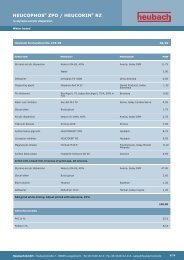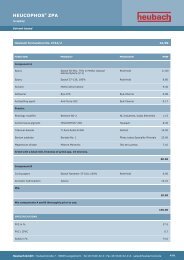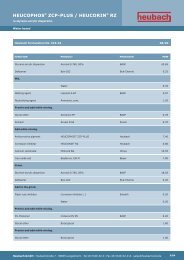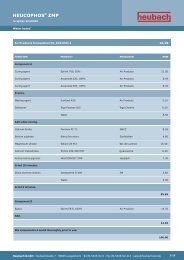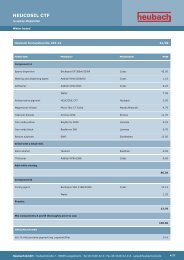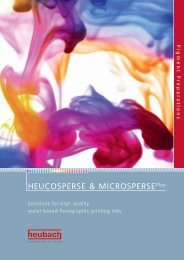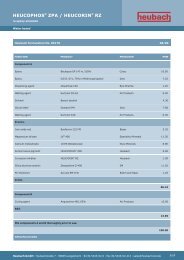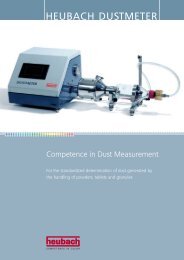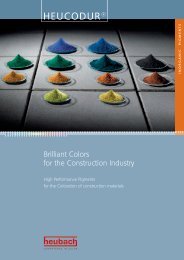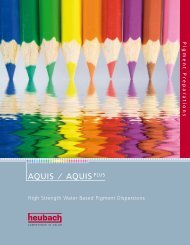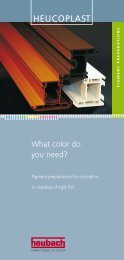IR Reflecting Pigments - Heubach GmbH
IR Reflecting Pigments - Heubach GmbH
IR Reflecting Pigments - Heubach GmbH
Create successful ePaper yourself
Turn your PDF publications into a flip-book with our unique Google optimized e-Paper software.
<strong>IR</strong> <strong>Reflecting</strong> <strong>Pigments</strong><br />
Hot <strong>Pigments</strong> for Cool Solutions<br />
I n o r g a n i c P i g m e n t s
HEUCODUR ® <strong>IR</strong> Introduction<br />
Hot <strong>Pigments</strong> for Cool Solutions<br />
Jumping out of the box is an objective every pioneering<br />
and forward-thinking coatings chemist or engineer likes<br />
to achieve.<br />
Modern and innovative coatings are striving for an<br />
apparent break-through effect that imparts the coating<br />
system an obvious added value. This ambition is driven by<br />
the general need for creating more and more cost efficient<br />
products without turning them into commodities.<br />
To prevail it is essential to focus on the right raw materials.<br />
One of the most innovative options is the use of “smart”<br />
materials.<br />
A smart pigmentation is a pigmentation that is capable to<br />
respond to changes in its environment or that may also<br />
exhibit an unexpected functionality.<br />
Fig. 1 Solar Spectrum<br />
Fig. 2 Electromagnetic reflection profiles of different pigments<br />
What does thermo controlling mean?<br />
It is well known, that a white surface remains cool, while a black one<br />
heats up. The reason for this is the interaction of the coated object with<br />
the near infrared-radiation (N<strong>IR</strong>) emitted by the sun (Fig. 1).<br />
When radiation is absorbed light is physically converted into heat. A<br />
surface interacts not only by absorbing radiation but also by emitting<br />
in the far infrared region until the equilibrium at a certain temperature<br />
is reached. The sun emits almost 50% of its energy as N<strong>IR</strong>-radiation. By<br />
using a conventional pigmentation this effect could result in a severe<br />
build-up of heat due to the unwanted absorption of radiation in the<br />
near infrared.<br />
Black surfaces strongly absorb N<strong>IR</strong>- and visible light, while white surfaces<br />
are effective in reflecting N<strong>IR</strong>- and visible light. But white or pastel colors<br />
cannot always satisfy the consumer’s demands.<br />
Differently colored pigments exhibit different, specific electromagnetic<br />
reflection profiles as shown in Fig. 2.<br />
Focusing on the <strong>IR</strong>-range (780-2500 nm) a pigment like rutile yellow<br />
exhibits the highest reflection followed by titanium dioxide. On the<br />
other hand carbon black benchmarks the lowest reflection. Compared<br />
to carbon black a considerable higher reflectance in the N<strong>IR</strong>-region<br />
of the solar spectrum can be achieved by a specifically designed <strong>IR</strong>-<br />
reflecting spinel black pigment.
HEUCODUR ® <strong>IR</strong> Performance<br />
These different and characteristic reflectance curves are also mirrored<br />
in different heat build-up curves shown in Fig. 3. In the heat build-<br />
up experiment a coated or pigmented objects is exposed to artificial<br />
N<strong>IR</strong>-light in a closed box under defined conditions. The increase of<br />
temperature is measured in relation to the duration of exposure.<br />
By reflecting the N<strong>IR</strong>-radiation more efficiently, this pigmentation gives<br />
coatings the ability to significantly reduce the surface temperature. This<br />
effect can be visualized by a thermo-imaging camera as shown in Fig.<br />
4.<br />
The thermo images show coated panels pigmented with different <strong>IR</strong>-<br />
reflecting pigments on the left side and with carbon black on the right<br />
side respectively. Afterwards the panels were homogeneously irradiated<br />
using an <strong>IR</strong>-lamp under defined conditions.<br />
The advantage we can get from this approach is not only a reduction<br />
of the heat build-up that can be correlated with decreased energy<br />
consumption. The benefit is also an enhanced shelf life of the coating<br />
or the pigmented object.<br />
Due to the significant reduction in surface temperature, thermal<br />
degradation of the polymeric matrix is reduced. In addition temperature<br />
differences between day and night, direct sunlight and shadowed areas<br />
etc. will also be levelled out. As a consequence thermal warping and<br />
thermal stress for instance becomes less effective.<br />
This aspect of the use of thermo controlling pigments is very important,<br />
because this effect can be utilised for numerous other applications -<br />
not only housing, roofing and facades. This is the key reason, why this<br />
approach truly deserves the label SMART. Not only because it contributes to a more environmentally aware use of resources, but also<br />
because of its exceptional ability to extend the shelf life of exterior coatings or polymers.<br />
Hence it really is a tool to impart sustainability.<br />
Fig. 5 Effect of different polymeric matrices on the reflectance of titanium<br />
dioxide pigmented systems<br />
Smart Complex Inorganic Colored <strong>Pigments</strong><br />
We are looking for efficient <strong>IR</strong>-reflecting pigments offered in different<br />
color shades, exhibiting an outstanding durability to their intended use<br />
in exterior applications and available on large scale.<br />
In order to select the right pigments we need to dig a little bit deeper<br />
into theory:<br />
Comparing pigments regarding their influence on the heat build-up<br />
always depends on the polymeric matrix. Fig. 5 shows as an example<br />
the different reflectance curves of titanium dioxides in different matrices.<br />
As a consequence the characteristic absorption of solar radiation needs<br />
to be taken into consideration when designing an effective <strong>IR</strong>-reflecting<br />
coating formulation.<br />
Fig. 3 Heat build-up profiles of different pigments according to ASTM D 4803-97<br />
Fig. 4 Surface temperature visualized by a thermo imaging camera
HEUCODUR ® <strong>IR</strong> Performance<br />
What is TSR?<br />
When selecting an effective <strong>IR</strong>-reflecting pigment the most important factor is the TSR value. TSR means Total Solar Reflectance and is<br />
the integral total amount of solar energy that is immediately rejected by a surface material (e.g. coating). That means that it includes UV-,<br />
visible- as well as N<strong>IR</strong>-radiation and is thus a key figure to describe the heat build-up of surfaces.<br />
Due to the fact, that the TSR covers the entire range of radiation between UV and N<strong>IR</strong>, e.g. black pigments show systematically lower TSR<br />
values compared to e.g. white pigments. Therefore only TSR values of similar pigments should be compared.<br />
A high TSR value indicates efficient reflection - a low TSR value indicates a strong tendency to absorb N<strong>IR</strong>-light and therefore induce<br />
significant heat build-up. It is helpful to interpret the TSR value in relation to the matrix used and/or a reference pigment (e.g. titanium<br />
dioxide).<br />
Furthermore it should be considered, that even small amounts of impurities can negatively affect the TSR of the coating. Even fillers,<br />
which are usually added to the paint, can potentially reduce the resulting reflectance in the near infrared.<br />
Pigment<br />
Titanium Dioxide<br />
HEUCODUR ® <strong>IR</strong> Black 940<br />
HEUCODUR ® <strong>IR</strong> Black 910<br />
HEUCODUR ® <strong>IR</strong> Black 950<br />
Carbon Black<br />
The Solution<br />
To achieve maximum reflection of solar radiation a N<strong>IR</strong>-reflective<br />
pigmentation is required, that provides a high TSR value and the highest<br />
outdoor durability. All these requirements can be fulfilled by mixed<br />
metal oxide pigments, which exhibit specially designed reflectance<br />
characteristics whilst retaining their excellent weather and light fastness<br />
(Fig. 6) as well as their exceptional temperature resistance.<br />
Looking at the thermo images in Fig. 4 the effect of different TSR values<br />
becomes apparent:<br />
The difference in the TSR values of approximately 5% on the left panel<br />
and 17% on the right panel results in a drastically stronger heat build-<br />
up of the carbon black pigmented coil coating.<br />
Coil Coating<br />
(PES/melamine)<br />
Tab. 1 TSR of different pigments in different matrices compared to titanium dioxide<br />
TSR (absolute)<br />
alkyd/<br />
melamine<br />
rigid PVC<br />
76% 85% 79%<br />
24% 24% 23%<br />
22% 21% 21%<br />
10% 9% 10%<br />
5% 5% 5%<br />
Fig. 6 Florida weathering results of <strong>IR</strong>-reflecting pigments
HEUCODUR ® <strong>IR</strong><br />
The Solution<br />
These novel, <strong>IR</strong>-reflecting complex inorganic colored<br />
pigments offer a wide range of color shades from<br />
yellow to black. They allow the formulation of not only<br />
architectural, building and construction coatings, tiles,<br />
plasters etc., but also automotive exterior and interior<br />
applications like dash-boards, fuel tanks, etc.<br />
Because of the reduced surface temperature the use of<br />
these pigments extends the shelf-life of the polymeric<br />
matrix through a minimization of thermo induced<br />
degradation effects and of course substantially reduces<br />
the heat build-up. This smart effect is not only possible<br />
in chromatic formulations but also especially in the<br />
achromatic range convincing effects can be achieved.<br />
As mentioned above titanium dioxide is one of the<br />
best performing pigments in terms of TSR value. But<br />
on the other hand carbon black or iron oxide blacks<br />
are on the contrary the lowest performing pigments<br />
in terms of TSR.<br />
But what happens when titanium dioxide and carbon<br />
black are blended to create grey color shades?<br />
The effect of carbon black on the heat-build-up of grey objects is significant and in the context of maximizing TSR it can be seen as a<br />
matter of “contamination”. Implementing even small amounts of carbon black or iron oxide blacks drastically reduces the N<strong>IR</strong> reflectivity<br />
of the entire system leading to higher heat build-up effects.<br />
Brightness L *<br />
Pigmentation<br />
TSR (%)<br />
Max. Temperature (%)<br />
Therefore an optimal pigmentation strategy avoids the usage of carbon black or iron oxide blacks and introduces the special N<strong>IR</strong><br />
reflective HEUCODUR ® <strong>IR</strong> pigments. The results of brightness adjusted exchanges of carbon black versus HEUCODUR ® <strong>IR</strong> 950 are<br />
displayed in Tab. 2.<br />
P.Bk. 7<br />
14<br />
71.7<br />
49.5<br />
HEUCODUR ® <strong>IR</strong><br />
Black 950<br />
Tab. 2 TSR values and maximum object temperatures after 30 minutes exposure to artificial N<strong>IR</strong> radiation of different adjusted formulations based upon titanium dioxide and varying<br />
amounts of carbon black or HEUCODUR ® <strong>IR</strong> Black 950 respectively.<br />
Only by using N<strong>IR</strong> reflective blacks maximum TSR values and minimum heat build-up effects could be accomplished.<br />
By that they take care for the customer’s comfort as a result of reducing the heat build-up and thus his electricity bill.<br />
21<br />
63.0<br />
P.Bk. 7<br />
23<br />
73.5<br />
62.7<br />
HEUCODUR ® <strong>IR</strong><br />
Black 950<br />
34<br />
64.0<br />
P.Bk. 7<br />
41<br />
73.0<br />
78.0<br />
HEUCODUR ® <strong>IR</strong><br />
Black 950<br />
54<br />
58.3
HEUCODUR ® <strong>IR</strong> Products<br />
Name Full Shade Reduction<br />
Pigment Color Index<br />
Nickel and Chromium Rutile <strong>Pigments</strong><br />
HEUCODUR ® PLUS <strong>IR</strong> Yellow 150 Nickel Antimony Titanium Yellow Rutile P.Y. 53<br />
HEUCODUR ® <strong>IR</strong> Yellow 152 Nickel Antimony Titanium Yellow Rutile P.Y. 53<br />
HEUCODUR ® <strong>IR</strong> Yellow 3R Chrome Antimony Titanium Buff Rutile P.Br. 24<br />
HEUCODUR ® <strong>IR</strong> Yellow 256 Chrome Antimony Titanium Buff Rutile P.Br. 24<br />
HEUCODUR ® <strong>IR</strong> Yellow 259 Chrome Antimony Titanium Buff Rutile P.Br. 24<br />
(Inverse) Spinel <strong>Pigments</strong><br />
HEUCODUR ® <strong>IR</strong> Blue 550 Cobalt Aluminate Blue Spinel P.B. 28<br />
HEUCODUR ® <strong>IR</strong> Blue 2R<br />
HEUCODUR ® <strong>IR</strong> Blue 4G<br />
Cobalt Aluminate Blue Spinel P.B. 28<br />
HEUCODUR ® <strong>IR</strong> Blue 5-100 Cobalt Chromite Blue Green Spinel<br />
Cobalt Chromite Blue Green Spinel<br />
HEUCODUR ® <strong>IR</strong> Green 5G Cobalt Titanate Green Spinel P.G. 50<br />
Browns & Blacks<br />
HEUCODUR ® <strong>IR</strong> Brown 869 Chromium Iron Oxide P.Br. 29<br />
HEUCODUR ® <strong>IR</strong> Black 910 Chromium Iron Oxide P.Br. 29<br />
HEUCODUR ® <strong>IR</strong> Black 940<br />
HEUCODUR ® <strong>IR</strong> Black 950 Chrome Iron Nickel Black Spinel P.Bk. 30<br />
P.B. 36<br />
P.B. 36<br />
Chromium Iron Oxide P.Br. 29<br />
HEUCODUR ® <strong>IR</strong> Black 945 Chromium Iron Oxide P.Br. 29<br />
Due to the limitation of printing process, some slight variations between the color as illustrated may be observed.
HEUCODUR ® <strong>IR</strong><br />
TSR<br />
[ % ] 1)<br />
Oil<br />
Absorption<br />
[ ml/100g ] 2)<br />
Heat<br />
Resistance<br />
[ ˚C ] 3)<br />
72 16 800<br />
72 17 800<br />
68 20 600<br />
64 17 800<br />
62 16 800<br />
51 30 800<br />
47<br />
33 17<br />
30 600<br />
41 17 800<br />
43 15 800<br />
26 17<br />
31 22<br />
14 17<br />
800<br />
28 25 700<br />
800<br />
800<br />
22 20 800<br />
800<br />
Technical Data<br />
Automotive<br />
Coatings<br />
Industrial<br />
Coatings<br />
Coil<br />
Coatings<br />
Powder<br />
Coatings<br />
Decorative<br />
Coatings<br />
Concrete,<br />
Plasters<br />
PVC<br />
Our recommendation<br />
1) powder pellet 2) according to DIN EN ISO 787/5 3) AA10/CIC/104<br />
PO<br />
Engineering<br />
Plastics<br />
Fibre
® = Registered trademark of <strong>Heubach</strong> <strong>GmbH</strong><br />
Our product specific and application information are based upon our current knowledge. They are non-binding and cannot be taken as a guarantee. The processing company must<br />
establish the suitability of individual products itself. As their use lies beyond our knowledge and control, we cannot accept any liability relating to the use of our products in particular<br />
applications. In addition to that, the legal rights of third parties must always be considered. The specification agreed between the customer and ourselves is the basis upon which our<br />
general sales and delivery conditions are set and is the deciding factor concerning any liabilities. Our standard specification is then valid if no specification has been agreed upon between<br />
the customer and ourselves.<br />
www.heubachcolor.de<br />
Europe: <strong>Heubach</strong> <strong>GmbH</strong> · <strong>Heubach</strong>straße 7 · 38685 Langelsheim · Germany · Tel 49-5326-52-0 · Fax 49-5326-52-213<br />
USA: Heucotech Ltd. · 99 Newbold Road · Fairless Hills, PA 19030 · USA · Tel 1-800-HEUBACH · Fax 1-215-736-2249<br />
Asia: <strong>Heubach</strong> Colour Pvt. Ltd. · 2nd Floor, Landmark-Building · Race Course Circle · Baroda 390 007 · India · Tel 91-265-2343-310 · Fax 91-265-2341-682<br />
Hangzhou <strong>Heubach</strong> Pigment Co., Ltd · Room 11-1-302, Da Shi Jie Wu Jin Cheng, 168 Jian Ding Road, Hangzhou 310021 · China · Tel 86-573-87634106 · Fax 86-573-87967925<br />
E-Mail: sales@heubachcolor.de<br />
10/2011



